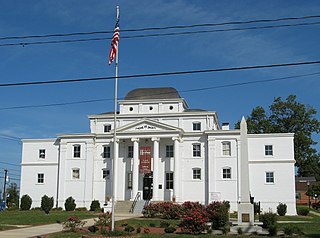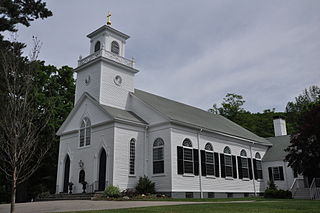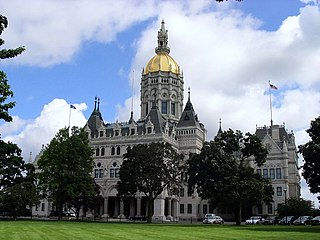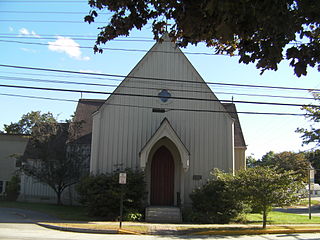
Wilkesboro is a town in and the county seat of Wilkes County, North Carolina, United States. The population was 3,687 at the 2020 census. The town is located along the south bank of the Yadkin River, directly opposite the town of North Wilkesboro. Wilkesboro is a Small Town Main Street community and has recently revitalized its historic downtown to include the Carolina West Wireless Community Commons, Wilkes Communications Pavilion, Heritage Square and Splash Pad. Cub Creek Park is adjacent to the downtown and contains many amenities, which include baseball, walking trails, mountain biking trails, trout fishing, dog park, basketball, tennis, and pickleball courts, picnic shelters, etc. Wilkesboro is also the home of the annual MerleFest, Carolina in the Fall, and Brushy Mountain Peach & Heritage festivals.
Christ Episcopal Church may refer to the following similarly named churches or parishes in the United States:
St. Paul's Episcopal Church or variants may refer to:

John Rudolph Niernsee was an American architect. He served as the head architect for the Baltimore and Ohio Railroad. Rudolph also largely contributed to the design and construction of the South Carolina State House located in Columbia, South Carolina. Along with his partner, James Crawford Neilson, Rudolph established the standard for professional design and construction of public works projects within Baltimore and across different states in the United States.

St. Mary's Episcopal Church and Cemetery is a historic church and cemetery at 258 Concord Street, in the village of Newton Lower Falls, Massachusetts, United States. St. Mary's Parish was formed in 1811. The church, built in 1813–14 and restyled in 1838, is the oldest church in Newton, and is a fine example of Gothic Revival/Federal style architecture. The cemetery, which dates from 1812, is the oldest non-government-owned cemetery in Newton. The property was listed on the National Register of Historic Places in 1980.
Henry C. Dudley (1813–1894), known also as Henry Dudley, was an English-born North American architect, known for his Gothic Revival churches. He was a founding member of the American Institute of Architects and designed a large number of churches, among them Saint Paul's Episcopal Cathedral in Syracuse, New York, built in 1884, and Trinity Church, completed in 1858.

The Church of the Incarnation built in 1896 is a historic Carpenter Gothic Episcopal church building located at 111 North 5th Street in Highlands, Macon County, North Carolina.

St. John the Baptist Church is a historic Episcopal church located at 118 High Street in the Sanbornville village of Wakefield, New Hampshire, in the United States. Built 1876–77, it is a prominent regional example of Carpenter Gothic architecture. It was listed on the National Register of Historic Places in 1984. Information about the church and leadership can be found on their website.

Richard Michell Upjohn, FAIA, was an American architect, co-founder and president of the American Institute of Architects.

Edward Brickell White, also known as E. B. White, was an architect in the United States. He was known for his Gothic Revival architecture and his use of Roman and Greek designs.

St. Philip's Episcopal Church is an historic Episcopal church located in the High Hills of Santee, in the antebellum summer resort community of Bradford Springs in Lee County, South Carolina, about six miles north of Dalzell.

St. Paul's Episcopal Church is a historic church at 27 Pleasant Street in Brunswick, Maine. Built in 1845, it is a distinctive early example of a modest Carpenter Gothic design by Richard Upjohn, then already well known for his larger-scale Gothic churches. The building was listed on the National Register of Historic Places in 1978. The Rector is the Rev. Dr. Matthew R. Scott.

St. Paul's Episcopal Church is a historic church building at Bridge Street and Vermont Route 14 in Royalton, Vermont. Built in 1836, it is a prominent early example of Gothic Revival architecture in the state, and is one of the oldest surviving public buildings in Royalton's historic village center. Now deconsecrated and maintained by the Royalton Historical Society, it was listed on the National Register of Historic Places in 2001.

St. Luke's Episcopal Church and Cemetery is a historic Episcopal church complex, cemetery, and national historic district located at 303-321 N. Cedar Street, 322 E. McBee Street in Lincolnton, Lincoln County, North Carolina. The complex includes the church, parish hall, and rectory. The church was built in 1885–1886, and is a Late Gothic Revival-style frame structure with a brick veneer added in 1922–1923. The tower is believed to date to 1859. The parish hall was built in 1907, and is a one-story, rectangular frame building. The rectory was built in 1911–1912, and is a two-story, "T"-form Colonial Revival-style dwelling with a pebbledash finish. The cemetery includes approximately 300 gravestones, with the earliest dating to 1854.

Saint Agnes Episcopal Church is a historic building located in Franklin, North Carolina, United States. It is a Chapel of All Saints Episcopal Church. From 1888 until 2014 St. Agnes was its own Episcopal Parish but in November of that year it officially merged with St. Cyprian's Episcopal Church to form an entirely new parish: All Saints Episcopal Church. All Saints is one congregation making use of two buildings: St. Agnes Chapel and St. Cyprian's Chapel. They use their website and Facebook to publish their worship schedule and keep parishioners and visitors up to date on where worship will be each Sunday.

Episcopal Church of the Advent is a historic Episcopal church at 141 Advent Street in Spartanburg, South Carolina.
Wheeler & Runge was an American architectural partnership based in Charlotte, North Carolina. The series of partnerships formed by Oliver Duke Wheeler also included Wheeler, Runge & Dickey. and Wheeler & Stern.

Brown-Cowles House and Cowles Law Office, also known as the Paul Osborne House and Law and Bride Cottage, is a historic home and law office located at Wilkesboro in Wilkes County, North Carolina, United States. The Cowles Law Office was built about 1871, and is a small one-story frame building with gable roof and single-shoulder end chimney. The original section of the Brown-Cowles House was built about 1834, and enlarged with a two-story wing by 1885 and enlarged again between 1920 and 1926. It is a two-story frame dwelling with Federal style detailing. Also on the property are the contributing curing house and kitchen. It was the home of William H. H. Cowles (1840-1901), a lawyer and four-term Congressman during the 1880s and 1890s.

Thomas B. Finley Law Office, also known as the J. F. Jordan Law Office, is a historic law office located at Wilkesboro, Wilkes County, North Carolina. It was built during the early 1880s, and is a small one-story frame building one room wide and two deep. It has sawnwork bargeboards and decorative finials in the Carpenter Gothic style. It is owned by the Wilkes Heritage Museum.



















